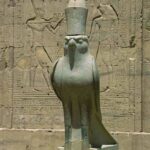Goddess Isis:
Wife of Osiris and mother of Horus, linked with funerary rites, motherhood, protection, and magic. She became a major deity in Greek and Roman religion. Isis is represented with a throne on her head and sometimes shown breastfeeding the infant Horus. In this manifestation she was known as “Mother of God.” To the Egyptians she represented the ideal wife and mother; loving, devoted, and caring.
The Goddess of Fertility. She was also the goddess of magic and a healing goddess.
Isis is the wife and sister of Osiris and the mother of Horus (the falcon). Her name means “the throne“. She is usually represented in a shape of a lady and sometimes a lady with 2 stretched wings.
As a goddess of magic, it is believed that Isis took the shape of the bird and was flying allover the land of Egypt looking for the parts of the body of her husband Osiris after being killed, that’s why one of her shapes is a lady with 2 wings to commemorate the myth of Osiris.
Her cult center was in Aswan and she has a beautiful temple built up on an island called Philae temple.
The origins of Isis are obscure. Unlike many gods, she can’t be tied to a specific town, and there are no certain mentions of her in the earliest Egyptian literature. Over time she grew in importance, though, eventually becoming the most important goddess in the pantheon. As the devoted wife who resurrected Osiris after his murder and raised their son, Horus, Isis embodied the traditional Egyptian virtues of a wife and mother.
As the wife of the god of the underworld, Isis was also one of the main deities concerned with rites for the dead. Along with her sister Nephthys, Isis acted as a divine mourner, and her maternal care was often depicted as extending to the dead in the underworld.
Isis was one of the last of the ancient Egyptian gods to still be worshipped. In the Greco-Roman period she was identified with the Greek goddess Aphrodite and her cult spread as far west as Great Britain and as far east as Afghanistan. It is believed that depictions of Isis with the infant Horus influenced Christian imagery of Mary with the infant Jesus.
Isis – The most powerful and popular goddess in Egyptian history. She was associated with virtually every aspect of human life and, in time, became elevated to the position of supreme deity, “Mother of the Gods”, who cared for her fellow deities as she did for human beings. She is the second-born of the First Five Gods (Osiris, Isis, Set, Nephthys, and Horus the Elder), sister-wife of Osiris, mother of Horus the Younger, and symbolically understood as the mother of every king. Her Egyptian name, Eset, means “Goddess of the Throne” because of her association with the monarch. She was also known as Weret-Kekau, “The Great Magic”, because of her incredible powers. She cared for people in life and appeared to them after death to help guide them safely to paradise. After the conquest of Egypt by Alexander the Great in 331 BCE, her worship traveled to Greece and then to Rome. During the time of the Roman Empire, she was worshipped in every corner of their realm from Britain through Europe to Anatolia.
The Cult of Isis was the strongest opponent of the new religion of Christianity between the 4th-6th centuries CE, and iconography, as well as tenets of belief, of the Isis cult were incorporated into the new faith. Imagery of the Virgin Mary holding her son Jesus comes directly from Isis cradling her son Horus and the Dying and Reviving God figure of Jesus himself is a version of Osiris.
Osiris’s wife was the goddess of magic, and clever and ambitious woman. She tricked Ra into retiring by poisoning him with a magic snake, then encouraging the old sun god to reveal his secret name so Isis could cure him. Once Isis knew Ra’s secret name, she could force him to do just about anything. She encouraged him to retreat into the sky, opening the throne for Osiris. Isis was the patron of magicians, and loved her husband very much. She encouraged their son Horus to take vengeance on the evil Set, who had killed Osiris. Isis is often pictured as a beautiful woman with multicolored wings.
Isis was associated with funeral rites and said to have made the first mummy from the dismembered parts of Osiris. As the enchantress who resurrected Osiris and gave birth to Horus, she was also the giver of life, a healer and protector of kings.
Her most famous temple is at Philae though her cult spread throughout the Medi-terranean world and, during the Roman period, extended as far as northern Europe. There was even a temple dedicated to her in London.










